Last updated on March 4th, 2024 at 08:19 am
Pets such as dogs and cats are cherished members of our families. While indoor plants undoubtedly enhance the aesthetics of our homes, some can pose risks to our furry companions. Dogs, driven by curiosity, may unknowingly sniff or taste these plants, unaware of their potential danger. Popular houseplants that are toxic to dogs have the potential to harm them if ingested. Therefore, this list has been compiled to help pet owners know about plants that might be dangerous for their dogs.
For people with dogs, understanding which plants can be dangerous is crucial. Young dogs, particularly puppies, are naturally curious and may often chew on plants. This list specifically identifies popular houseplants that are toxic to dogs, providing essential guidance for pet owners to recognize and avoid indoor plants that could potentially endanger their furry friends’ well-being, ensuring their safety and happiness.
Contents
- 1 11 Houseplants That Are Toxic To Dogs
- 2 FAQS
- 2.1 What should I do if my dog ingests a toxic plant?
- 2.2 What are the common symptoms of plant toxicity in dogs?
- 2.3 How can I protect my dog from toxic houseplants?
- 2.4 Can the severity of plant toxicity vary among different dog breeds?
- 2.5 Are there safe alternatives to the toxic houseplants mentioned?
- 2.6 Are all parts of the mentioned houseplants toxic to dogs?
- 3 Author
11 Houseplants That Are Toxic To Dogs
Here are 11 popular houseplants that are toxic to dogs.
Aloe Vera
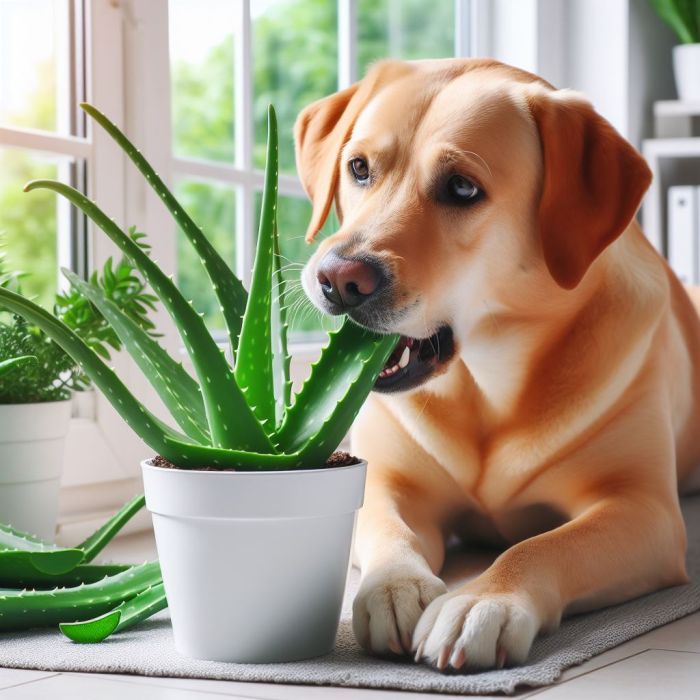
Aloe Vera’s Healing Properties
Aloe Vera, renowned for its soothing effects on human skin, is a well-known plant recognized for its beneficial properties.
Cautionary Note for Dogs
Despite the plant’s positive reputation for humans, caution is warranted when it comes to dogs consuming any part of Aloe Vera, as it falls under the category of popular houseplants that are toxic to dogs.
Harmful Components and Digestive Concerns
Certain components in the outer leaf parts, specifically anthraquinone glycosides, can be harmful to dogs, potentially causing digestive issues if ingested, which is a common concern associated with popular houseplants that are toxic to dogs.
Signs of Ingestion and Preventive Measures
Chewing on the aloe plant can lead to stomach discomfort in dogs, manifesting as symptoms like diarrhea and vomiting. Pet owners should take preventive measures to ensure their dogs don’t consume parts of the plant beyond the inner gel, which is generally safe for limited use.
Jade plant
The Jade plant, scientifically referred to as Crassula Ovata or simply jade, is a well-loved houseplant known for its robustness and ability to thrive over an extended period.
Potential Harm to Dogs
Despite its reputation for resilience, it falls under the category of popular houseplants that are toxic to dogs. It poses a potential threat to dogs if they ingest any part of it.
Symptoms and Caution
When dogs consume the jade plant, they may exhibit symptoms like vomiting, a slowed heart rate, and signs of depression. To safeguard the well-being of dogs, pet owners must exercise caution and take preventive measures to ensure that their animals do not chew on any portion of the plant.
Daffodils (Paper Whites, Narcissus, Jonquil)

Daffodils, also known as Paper Whites, Narcissus, and Jonquil, contain a substance called lycorine. This substance, found in the outer layer of the bulb, can make dogs vomit if they eat it. There are also tiny crystals in the bulb’s outer layer that can irritate a dog’s mouth, causing them to drool.
Signs of Trouble with Daffodils in Dogs
If a dog eats any part of the daffodil—whether it’s the bulb, plant, or flower—it can lead to serious problems as it is among the popular houseplants that are toxic to dogs. This includes severe vomiting, diarrhea, stomach pain, and even more serious issues like problems with the heart’s rhythm or difficulty breathing.
Beware of Spring’s Beautiful Yet Harmful Flowers
Daffodils, those beautiful yellow and white flowers that signal the arrival of spring, hide a danger for dogs. Eating any part of these flowers can cause significant issues like stomach problems, convulsions, seizures, low blood pressure, trembling, and problems with the heart’s rhythm. Pet owners need to be careful to prevent dogs from eating daffodils
Peace Lily
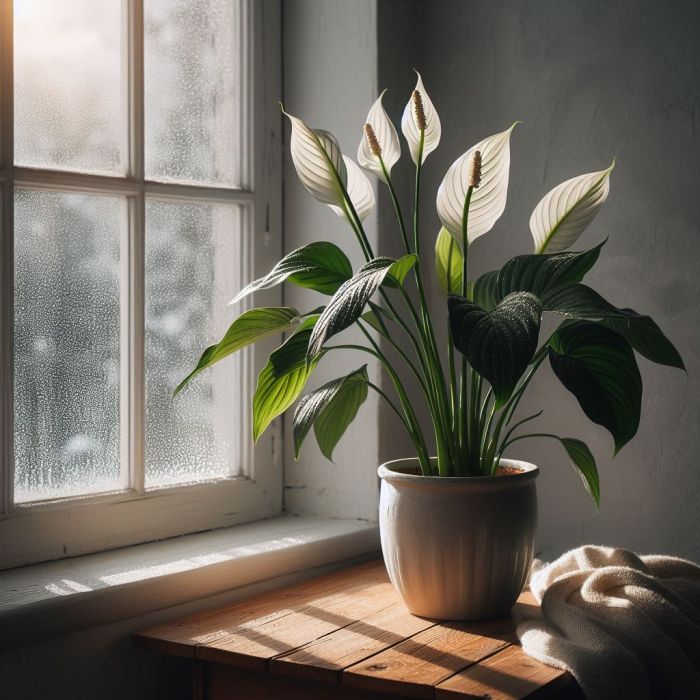
The peace lily, belonging to the Araceae family and containing irritating crystals, poses a risk if dogs chew on it. This can result in mouth and stomach discomfort, and in rare cases, difficulty breathing, as it is one of the popular houseplants that are toxic to dogs.
Safer Alternative to Some Lilies
Compared to more dangerous lilies like Easter or Tiger lilies, the peace lily doesn’t cause acute kidney failure in cats.
Recognizing Symptoms and Cautionary Care
Keep an eye out for signs like drooling, pawing at the mouth, oral pain, decreased appetite, and vomiting if your pet interacts with a peace lily. Despite being an easy-to-care-for houseplant, it is one of the popular houseplants that are toxic to dogs as its calcium oxalates can cause mild symptoms when chewed.
Sago Palms:
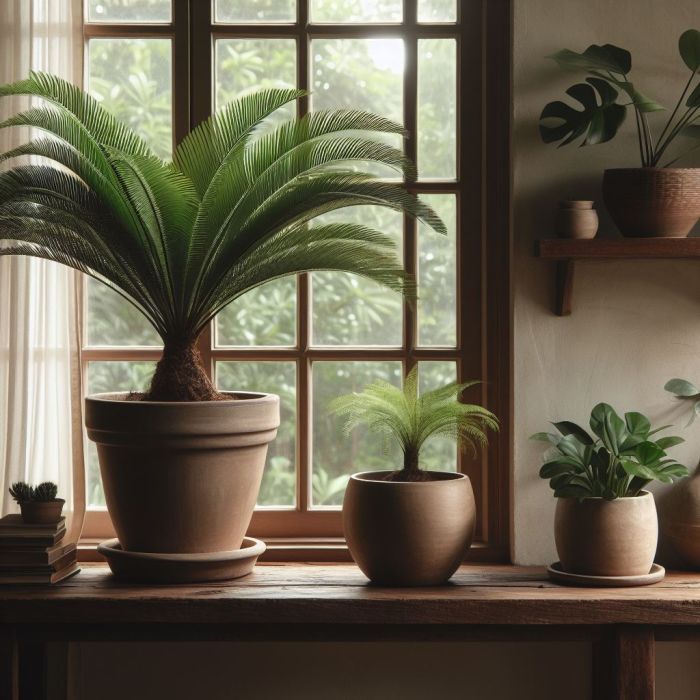
Sago palms might look cool, but they’re not safe for dogs because they fall under the category of popular houseplants that are toxic to dogs. People like having them in their homes or yards because they look nice and tropical, but they can make dogs sick.
Sago palms, whether big or small like the Bonsai ones, can hurt dogs. Every part, from roots to leaves and seeds, has something bad called cycasin. If a pet eats any of it, it can get very sick, and sometimes it’s even dangerous.
Spotting Problems: How Dogs React to Sago Palms
Dogs that eat sago palms might throw up, have diarrhea, feel tired, or their gums and eyes might turn yellow. It’s important to get them help fast, but even then, only about half of them get better. Sometimes, dogs can get shaky or have seizures a little while later.
Zamioculcas

Popular houseplants that are toxic to dogs include Zamioculcas zamiifolia, commonly known as the ZZ plant or Zanzibar gem. While generally considered safe for humans, it is crucial to be aware that this plant can pose mild toxicity risks for dogs if ingested. The adverse effects of the ZZ plant on dogs encompass as it is one of the houseplants that are toxic to dogs.
Oral Irritation
Ingesting parts of the ZZ plant can lead to oral discomfort in dogs, marked by symptoms like drooling, pawing at the mouth, and general discomfort.
Gastrointestinal Distress
Dogs consuming ZZ plant leaves or stems may experience gastrointestinal upset, resulting in symptoms such as vomiting, diarrhea, and abdominal pain.
Inappetence
Dogs that have ingested the ZZ plant may display a loss of appetite or reluctance to eat.
Lethargy
Toxic reactions to the plant can induce lethargy or unusual tiredness in dogs. Because the ZZ plant belongs to the popular houseplants that are toxic to dogs.
Hyacinths and Tulips
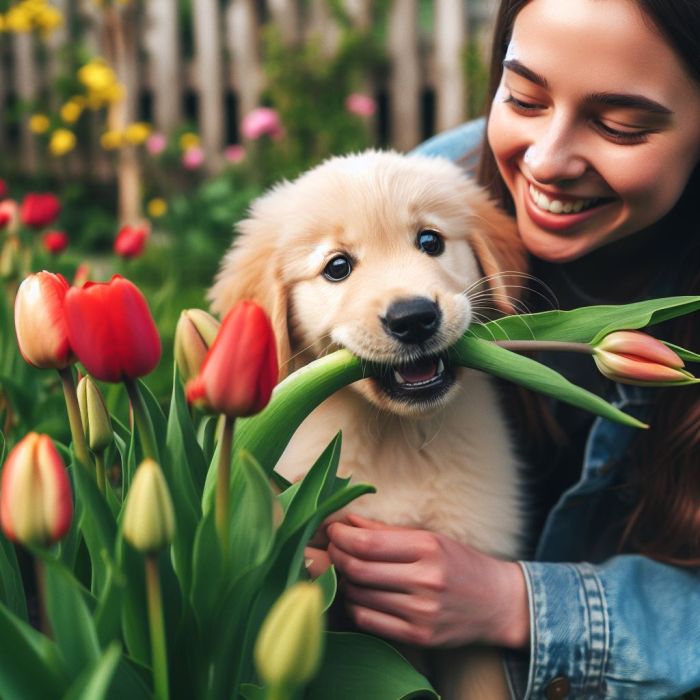
This plant belongs to the popular houseplants that are toxic to dogs because part of the Liliaceae family, hyacinths, and tulips contain allergenic lactones or similar alkaloids. These toxins are primarily found in the bulbs, and ingestion can lead to severe clinical symptoms. Poisoning incidents typically occur when dogs dig up recently planted bulbs.
Potential Risks for Dogs
These charming flowers, with their delightful scent, carry a warning for pet owners. If your dog ingests them, they may experience intense vomiting, sporadic diarrhea (potentially with blood), depression, and tremors.
Nerium Oleander

Esteemed for its enchanting flowers and perpetual greenery, this shrub has become a favored choice in gardens worldwide. However, it’s imperative to highlight that every element of this plant is considered toxic for a range of species, encompassing dogs, cats, humans, horses, cattle, and pigs.
Even a minute quantity of this plant can trigger toxicity, with reports indicating that imbibing water containing fallen leaves or handpicked flowers from this plant can also be harmful. The Nerium Oleander plant houses cardiac glycosides, especially cardenolides, disrupting the electrolyte equilibrium in the heart and other muscles, leading to cardiac and gastrointestinal complications.
Symptoms of Toxicity
Every component of the plant possesses toxic cardiac glycosides akin to digoxin. Ingestion can result in symptoms like colic, diarrhea (potentially bloody), perspiration, compromised coordination, breathlessness, respiratory difficulty, muscle tremors, and, in severe instances, fatality due to heart failure as it belongs to the popular houseplants that are toxic to dogs.
Emerald fern
As a popular houseplant that is dangerous to dogs, the Asparagus Fern, scientifically identified as Asparagus densiflorus and also known as emerald fern or sprengeri fern, is a widely chosen decorative plant in both gardens and homes, enhancing the visual appeal of indoor and outdoor spaces. However, pet owners must be aware of the potential risks it presents to dogs. Here are reasons why the Asparagus Fern, among popular houseplants that are toxic to dogs, can pose hazards to dogs
Toxic Components
The Asparagus Fern contains substances known as saponins, chemicals recognized for inducing irritation and toxicity in animals, dogs included. Ingesting any part of the plant, especially the berries, can lead to adverse effects.
Risk of Gastrointestinal Distress
The consumption of the Asparagus Fern may result in gastrointestinal upset in dogs, with symptoms such as vomiting, diarrhea, and abdominal pain. The saponins in the plant can irritate the digestive tract, causing these unfavorable reactions.
Potential for Oral Irritation
Chewing on or ingesting the Asparagus Fern can trigger oral irritation in dogs, characterized by symptoms like excessive drooling, pawing at the mouth, and discomfort.
Dieffenbachia
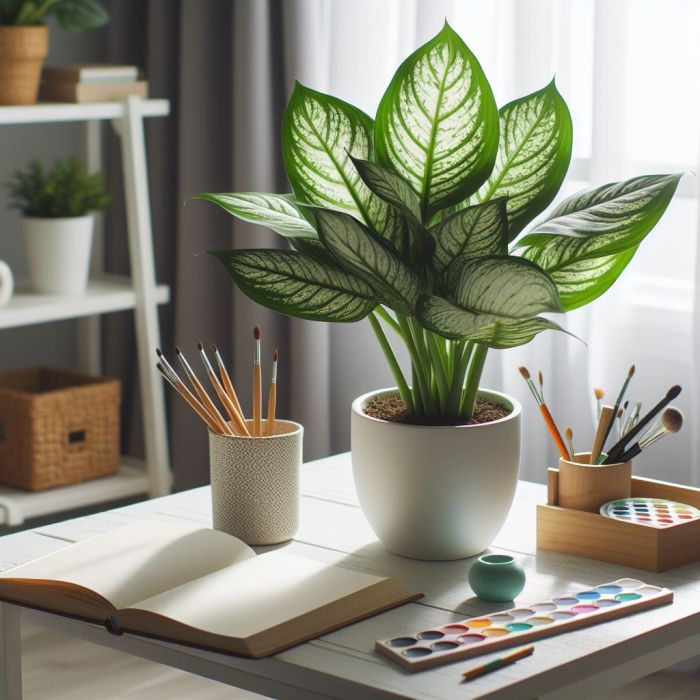
Widely embraced as a common house or office plant, dieffenbachia contains insoluble calcium oxalate crystals, reminiscent of the Swiss Cheese plant. In the event of ingestion or chewing, these crystals induce severe oral irritation, resulting in a burning sensation on the lips and tongue, and gastrointestinal tract irritation if swallowed.
Symptoms of Dieffenbachia Toxicity in Dogs
Extreme mouth irritation may lead to swelling of the tongue, lips, and face, accompanied by ulcers and blisters within the mouth. Other signs include excessive drooling, nausea, pawing at the face and mouth, vomiting, and in some cases, difficulty swallowing. In rare instances, inflammation-induced respiratory distress may cause swelling of the upper airway.
Toxins and Severity
Dieffenbachia contains insoluble calcium oxalates and a proteolytic enzyme, posing a moderate level of toxicity. The entire plant is considered malicious, and symptoms include mucous membrane irritation, intense burning, irritation of the mouth and lips, excessive drooling, vomiting, and difficulty swallowing.
Cyclamen

Admired for its blossoms, especially in winter, the cyclamen plant is a popular choice. However, it’s essential to be aware that every part of these plants contains triterpene glycoside saponins, making them toxic to dogs, with the tuber, or roots, having the highest concentration.
Indications of Cyclamen Toxicity in Dogs
Ingesting any portion of the cyclamen plant can lead to symptoms such as vomiting, diarrhea, and drooling. Yet, if dogs consume tubers or a significant quantity of any plant part, it may result in severe cardiac problems like irregular heartbeat (arrhythmias), seizures, and potential fatality.
Understanding the Risks
Cyclamen’s toxicity arises from triterpene glycoside saponins, with the tuber containing the highest concentration. Pet owners must exercise caution, particularly in winter when these flowering plants are in abundance.
FAQS
What should I do if my dog ingests a toxic plant?
Contact your veterinarian or an emergency animal poison control hotline immediately. Provide information about the plant, symptoms, and the quantity ingested. Do not attempt home remedies without professional guidance.
What are the common symptoms of plant toxicity in dogs?
Symptoms may vary but can include vomiting, diarrhea, drooling, oral irritation, lethargy, abdominal pain, and, in severe cases, organ failure or difficulty breathing. It’s essential to monitor your dog for any unusual behavior if you suspect plant ingestion.
How can I protect my dog from toxic houseplants?
Place toxic plants out of your dog’s reach, consider hanging them or using elevated plant stands. Educate yourself about the plants in your home and remove any that pose a risk. Train your dog to avoid plants, and supervise them closely, especially puppies and curious dogs.
Can the severity of plant toxicity vary among different dog breeds?
Yes, the susceptibility to toxicity can vary among individual dogs and breeds. Some dogs may have stronger reactions to certain plants than others. It’s essential to be cautious regardless of your dog’s breed.
Are there safe alternatives to the toxic houseplants mentioned?
Yes, there are many pet-friendly houseplants available. Consider plants like spider plants, Boston ferns, or pet-safe varieties of palms. Always verify the safety of a plant before introducing it to your home.
Are all parts of the mentioned houseplants toxic to dogs?
Yes, for the plants listed, all parts, including leaves, stems, flowers, bulbs, and roots, can be toxic to dogs. It’s important to keep dogs from chewing or ingesting any part of these plants.
In conclusion, being aware of popular houseplants that are toxic to dogs is crucial for pet owners. Safeguarding our furry companions involves understanding the potential risks associated with these plants and taking preventive measures to keep them out of reach. By prioritizing our pets’ safety and well-being, we can create a secure environment at home, minimizing the likelihood of plant-related health issues for our beloved canine friends.

